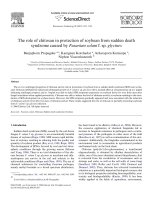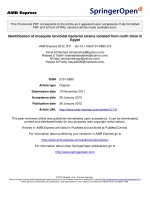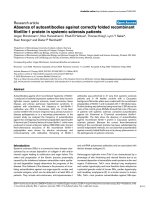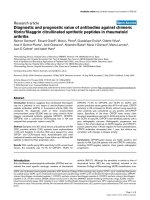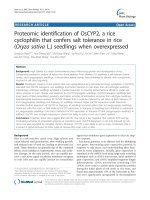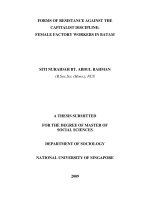Identification of sources of resistance against wilt (Fusarium oxysporum f. sp. ciceri) in chickpea genotypes under temperate agro-climatic conditions of Kashmir
Bạn đang xem bản rút gọn của tài liệu. Xem và tải ngay bản đầy đủ của tài liệu tại đây (192.74 KB, 5 trang )
Int.J.Curr.Microbiol.App.Sci (2018) 7(9): 195-199
International Journal of Current Microbiology and Applied Sciences
ISSN: 2319-7706 Volume 7 Number 09 (2018)
Journal homepage:
Original Research Article
/>
Identification of Sources of Resistance against Wilt
(Fusarium oxysporum f. sp. ciceri) in Chickpea Genotypes under
Temperate Agro-Climatic Conditions of Kashmir
Shifa Showket1, Sabiya Bashir2*, Mohammad Najeeb Mughal1, Reyaz-ul-Raouf Mir1,
F.A. Bhatt1 and T.A. Shah1
1
Division of Plant Pathology, Faculty of Agriculture, 2Dryland Agriculture Research Station,
S. K. University of Agricultural Sciences and Technology of Kashmir, Budgam-191132, India
*Corresponding author
ABSTRACT
Keywords
Chickpea, Fusarium wilt,
Genotype screening,
Kashmir, Temperate
agro-climatic conditions
Article Info
Accepted:
04 August 2018
Available Online:
10 September 2018
Thirty five chickpea genotypes in Chickpea International Elite Nursery Winter 2018
(CIEN-W-18), procured from ICARDA were evaluated against wilt caused by Fusarium
oxysporum f. sp ciceri during Rabi 2018 under temperate agro-climatic conditions of
Kashmir. None of the genotypes were found highly resistant, while only three genotypes
viz., FLIP10-355C, FLIP11-40C and FLIP11-45C were Resistant. Seven genotypes viz.,
FLIP10-332C, FLIP10-343C, FLIP11-125C, FLIP11-163C, FLIP11-175C, FLIP11-190C
and FLIP11-231C were moderately resistant while fourteen genotypes viz., FLIP10-318C,
FLIP10-333C, FLIP10-364C, FLIP11-05C, FLIP11-06C, FLIP11-09C, FLIP11-11C,
FLIP11-22C, FLIP11-32C, FLIP11-58C, FLIP11-134C, FLOP11-151C, FLIP11-193C and
FLIP93-93C were moderately susceptible. Eight genotypes viz., FLIP10-337C, FLIP10345C, FLIP11-21C, FLIP11-102C, FLIP11-66C, FLIP11-158C, FLIP82-150C and
FLIP88-85C were found susceptible and three genotypes (ILC482, FLIP11-08C and
FLIP10-338C) were highly susceptible.
Introduction
Chickpea (Cicer arietinum L.) is an important
pulse crop, which rank third after dry beans
(Phaseolus vulgaris L.) and dry peas (Pisum
sativum L.) (Dhar and Gurha, 1998). India is
largest producer of chickpea in the world
contributing 65.49 per cent in production and
65.25 per cent in area. In India chickpea is
grown on 81.17 lakh hectare of land,
producing 59.01 lakh tonnes with a
productivity of 727 kg ha-1(Anonymous,
2015). Fusarium oxysporum f. sp. ciceri (Foc,
Padwick) is a serious soil borne disease of
chickpea (Hossain et al., 2013) and was first
reported in Indo-Pak sub-continent by Butler
in 1918. It is one of the major constraints in
chickpea cultivation throughout the world
especially in Indian sub-continent where
chickpea is a commonly grown as pulse crop.
Nema and Khare (1973) reported yield loss
due to wilt upto 61 per cent if the infection
195
Int.J.Curr.Microbiol.App.Sci (2018) 7(9): 195-199
occurs at seedling stage and 43 per cent if the
infection occurs at flowering stage. In India, at
National level, the yield loss due to wilt may
vary between 5 to 10 per cent (Singh and
Dahiya, 1973). However, under congenial
weather conditions for disease, it may cause
complete (100 %) yield loss (Pande et al.,
2010; Kumari and Khanna, 2014).
Though reports on different aspects of the
disease are available from India and abroad,
very scanty information is available on this
disease from Jammu and Kashmir. Although
various chemical fungicides are available for
management of disease but they incur high
cost and cause environmental hazards and
deleterious effects on human health.
Identification of resistant genotypes is one of
the most suitable, cheap and eco-friendly
method of management of disease and
improving the farmers returns. Keeping in
view the importance of disease, socioeconomic status of the crop and inadequate
research work carried out, an attempt was
made to identify sources of resistance to the
disease in the genotypes procured from
ICARDA.
Materials and Methods
Thirty five genotypes, including four Checks
viz., ILC482, FLIP-82-150C, FLIP88-85C and
FLIP 93-93C, procured from ICARDA were
screened against the wilt under natural
epiphytotic
conditions
in
Chickpea
International Elite Nursery 2018 (CIEN-W18) at FOA, Wadura during Rabi 2017-18.
The genotypes were classified into Highly
Resistant (HR), Resistant (R), Moderately
Resistant (MR), Moderately Susceptible (MS),
Susceptible (S) and Highly Susceptible (HS)
groups on the basis of their response to disease
under natural epiphytotic conditions. All the
entries were planted in two replications.
Susceptible checks were planted in separate
plots. The length of each row was 4m and
width was 0.45m. The observation on wilt was
recorded as percentage of disease incidence
calculated by following formula:
No. of plants exhibiting wilt symptoms
Disease incidence (%) = ------------------ × 100
Total of total plants observed
A scale (0 – 5 point) was used for
categorization of genotypes.
Results and Discussion
The persual of data (Table 1 and 2) revealed
that in Chickpea International Elite Nursery
2018 (CIEN-W-18), none of the genotypes
recorded zero disease incidence and no
genotype was found Highly Resistant (HR).
However, three genotypes viz., FLIP10-355C,
FLIP11-40C and FLIP11-45C were Resistant
(R) with disease incidence ranging from 4.75
(FLIP10-355C) to 8.75 (FLIP11-45C) per cent
and seven genotypes viz., FLIP10-332C,
FLIP10-343C,FLIP11-163C, FLIP11-175C,
FLIP11-190C and FLIP11-231C were
Moderately Resistant (MR) with disease
incidence varying from 12.50 in genotype
FLIP11-125C to 18.00 per cent in genotype
FLIP11-163C and fourteen genotypes viz.,
FLIP10-318C, FLIP10-333C, FLIP10-364C,
FLIP11-05C, FLIP11-06C, FLIP11-09C,
FLIP11-11C, FLIP11-22C, FLIP11-32C,
FLIP11-58C, FLIP11-134C, FLOP11-151C,
FLIP11-193C
and
FLIP93-93C
were
designated as moderately susceptible with
disease incidence ranging from 21.00 (FIP1122C) to 28.00 (FLIP11-151C) per cent. Eight
genotypes
FLIP10-337C,
FLIP10-345C,
FLIP11-21C, FLIP11-102C, FLIP11-66C,
FLIP11-158C, FLIP82-150C and FLIP88-85C
were susceptible. Among the susceptible
genotypes, the lowest disease incidence
(35.00%) was recorded in genotype FLIP10337C while highest disease incidence
(49.00%) was recorded in FLIP11-150C
genotype.
196
Int.J.Curr.Microbiol.App.Sci (2018) 7(9): 195-199
Table.1 Reactions of genotypes in Chickpea International Elite Nursery 2018 (CIEN-W-18)
S. No
Genotype
01
02
03
04
05
06
07
08
09
10
11
12
13
14
15
16
17
18
19
20
21
22
23
24
25
26
27
28
29
30
31
32
33
34
35
FLIP10-355C
FLIP11-40C
FLIP11-45C
FLI10-332C
FLIP10-343C
FLIP11-125C
FLIP11-163C
FLIP11-175C
FLIP11-190C
FLIP11-231C
FLIP10-318C
FLIP10-333C
FLIP10-364C
FLIP11-05C
FLIP11-06C
FLIP11-09C
FLIP11-11C
FIP11-22C
FLIP11-32C
FLIP11-58C
FLIP11-134C
FLIP11-151C
FLIP11-193C
FLIP93-93C
FLIP10-337C
FLIP10-345C
FLIP11-21C
FLIP11-102C
FLIP11-66C
FLIP11-158C
FLIP11-150C
FLIP88-85C
ILC482
FLIP11-08C
FLIP10-338C
Per cent wilt incidence
4.75
7.75
8.75
15.75
13.00
12.50
18.00
17.75
11.00
16.25
23.50
25.00
25.00
27.75
22.25
21.00
24.75
21.25
24.75
24.00
22.50
28.00
21.00
23.00
35.00
38.25
40.50
42.00
43.50
45.00
49.00
43.75
53.00
55.75
52.75
197
Int.J.Curr.Microbiol.App.Sci (2018) 7(9): 195-199
Table.2 Categorization of chickpea genotypes / lines in CIEN-W-18
Category
0
1
Reaction
Average
(%)
Highly resistant 0
(none)
Resistant (3)
1-10
2
Moderately
resistant (7)
10-20
3
Moderately
susceptible (14)
20-30
4
Susceptible (8)
30-50
5
Highly
susceptible (3)
50 & above
wilt
incidence Genotypes/ Lines
FLIP10-355C, FLIP11-40C and FLIP1145C
FLIP10-332C, FLIP10-343C, FLIP11125C, FLIP11-163C, FLIP11-175C,
FLIP11-190C and FLIP11-231C
FLIP10-318C, FLIP10-333C, FLIP10364C,
FLIP11-05C,
FLIP11-06C,
FLIP11-09C, FLIP11-11C, FLIP11-22C,
FLIP11-32C, FLIP11-58C, FLIP11134C, FLOP11-151C, FLIP11-193C and
FLIP93-93C
FLIP10-337C, FLIP10-345C, FLIP1121C,
FLIP11-102C,
FLIP11-66C,
FLIP11-158C,
FLIP82-150C
and
FLIP88-85C
ILC482, FLIP11-08C and FLIP10-338C
Categorization scale (0 – 5)
Grade
0
1
2
3
4
5
Per cent mortality
No disease
1 to 10
10.1 to 20
20.1 to 30
30.1 to 50
50 and above
Disease reactions
Highly resistant (HR)
Resistant(R)
Moderately Resistant (MR)
Moderately Susceptible (MS)
Susceptible (S)
Highly Susceptible (HS)
(IIPR, 1999)
Three genotypes were found Highly
Susceptible and among them lowest disease
incidence (53.00%) was recorded in ILC482
followed by FLIP10-338C with disease
incidence of 52.75 while genotype FLIP1108C recorded the highest disease incidence of
56.75 per cent.
genotypes to wilt pathogen, Fusarium
oxysporum f. sp. ciceri under natural
epiphytotic conditions and the result indicated
that three genotypes were Resistant (R) and
which could be used as direct introductions or
sources of resistance in hybridization
programme.
In the present investigation the selection for
the resistance was based on the reaction of the
Korde, (2011), Mandhare et al., (2011) and
Kumar et al., (2012) gave been screened
198
Int.J.Curr.Microbiol.App.Sci (2018) 7(9): 195-199
Kumari, S. and Khanna, V. 2014. Effect of
antagonistic rhizobacteria coinoculated
with Mesorhizobium ciceris on control of
Fusarium wilt in chickpea (Cicer
arietinum L.). African Journal of
Microbiological Research. 8(12): 12551265.
Mandhare V. K., Deshmukh G. P., Patil J. V.,
Kale A. A. and Chavan U. D. 2011.
Morphological, pathogenic and molecular
characterization of Fusarium oxysporum
f. sp. ciceri isolates from Maharashtra,
India. Indonesian Journal of Agricultural
Sciences. 12 (2): 47-56.
Nema K. G. and Khare M. N. 1973. A
conspectus of wilt of Bengal gram in
Madhya pradesh. Symposium on wilt
problem and breeding for wilt resistance
in Bengal gram, Sept. 1973 at Indian
Agricultural. Research Institute, New
Delhi, India. 1-4 pp.
Pande, S, Desai, S., Sharma, M. 2010. Impacts
of climate change on rainfed crop
diseases: Current Status and Future
Research Needs. National Symposium on
Climate Change and Rainfed Agriculture,
Hyderabad. 18(20): 55-59.
Singh K. B. and Dahiya B. S. 1973. Breeding of
wilt resistance in chickpea. Symposium
on wilt problem and breeding for wilt
resistance in Bengal gram. September
1973 at IARI, New Delhi, India, 13-14.
pp.
Suryawanshi A V, Mandhare V K, Sanap M M
and Jamadagni B M 2003. Reaction of
chickpea entries to Fusarium wilt and
gram pod borer. J. Maharashtra Agric.
Univ. 28 (2): 213-214.
number of chickpea genotypes and identified
promising cultivars in India.
References
Anonymous 2015. Directorate of Economics
and Statistics, Department of Agriculture
and Cooperation. Agricultural statistics at
a glance. 9096 pp.
Dhar V. and Gurha S. N. 1998. Integrated
management of chickpea diseases.
(Rajeev, K., Upadhyay, K. G., Mukerji,
B. P., Chamola and Dubey, O. P. (edi.)),
APH Pub. Co., New Delhi. (India). 249
pp.
Hossain, M.M., Hossain, N., Sultana, F., Islam,
S.M.N., Islam, M.S. Bhuiyan, M.K.A.
2013.
Integrated
management
of
Fusarium wilt of chickpea (Cicer
arietinum L.) caused by Fusarium
oxysporum f. sp. ciceris with microbial
antagonist,
botanical
extract
and
fungicide. Afr. J. Microbiol. 12(29):
4699-4706.
IIPR 1999. Proceedings of technical programme
for Rabi workshop organization by Indian
Institute of Pulse Research Kanpur. 13 pp.
Korde M. G. 2011. Studies on Fusarium wilt of
chickpea caused by Fusarium oxysporum
f. sp. ciceri (Padwik) Synder and Hansan.
M. Sc. (Agri.) thesis submitted to
VNMKV, Parbhani (India).
Kumar A., Lal H. C. and Akhtar J. 2012.
Morphological
and
pathogenic
characterization of Fusarium oxysporum
f. sp. ciceri causing wilt of chickpea.
Indian Phytopathology. 65 (1): 64-66.
How to cite this article:
Shifa Showket, Sabiya Bashir, Mohammad Najeeb Mughal, Reyaz-ul-Raouf Mir, F.A. Bhatt and
Shah, T.A. 2018. Identification of Sources of Resistance against Wilt (Fusarium oxysporum f. sp.
ciceri) in Chickpea Genotypes under Temperate Agro-Climatic Conditions of Kashmir.
Int.J.Curr.Microbiol.App.Sci. 7(09): 195-199. doi: />
199
